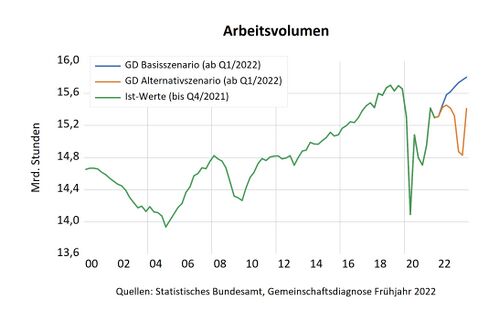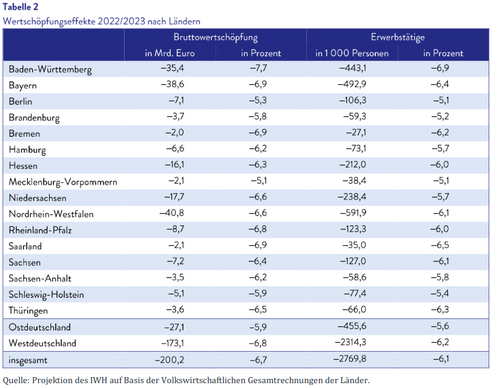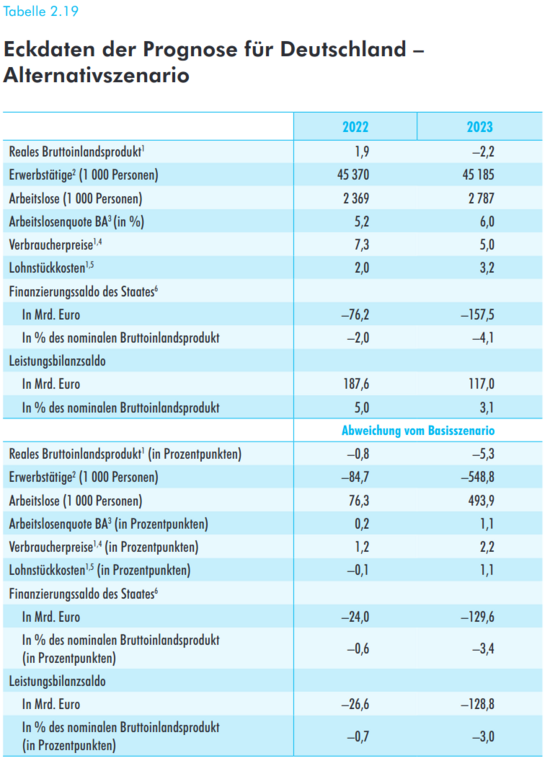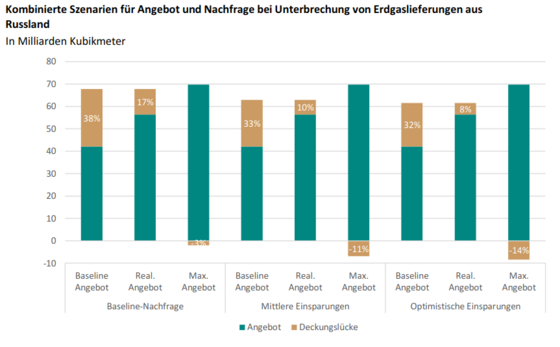IWH study: Regional effects of recession in Germany due to Russian gas supply cut
The April 2022 version of study comes to the conclusion that approx. 2.7 million (or 6.1%) jobs in Germany would be "affected" by the Russian gas supply cut starting in mid-April 2022, whereas Southern regions will be more affected than the Northern ones[1]. This result has been repeatedly used[2][3][4] as the "proof" that embargo will lead to "millions of lost jobs" and mass unemployment. However, this interpretation is wrong for the following reasons:
1. Not all "affected" jobs will be actually lost. Since gas supply shortage (if any) would be limited to just several weeks or months, both government and companies would take measures to preserve the workforce (furlough, reduced working hours etc.).
2. Many affected jobs do not exist (yet). The study uses "baseline scenario" as the reference, which assumes GDP growth of 2.7% in 2022 and 3.1% in 2023. In other words, most "affected" jobs would be "new" jobs not being created due to lack of growth, and not the existing jobs being lost due to recession.
3. The estimates are based on (now) obsolete data. The study assumes the Russian gas supply cut in mid-April, and hence estimates German gas storage at ~25% of capacity in June. In fact, storage level is at 52% as of June, 8th. This is a huge difference, which makes the costs of gas embargo for EU/German economy much lower compared to earlier estimates (although this "discount" was paid for by horrific human, humanitarian and economic losses in Ukraine). This is also acknowledged by an update of this study which has been released end of June 2022 (special analysis gas gap / Sonderauswertung Gaslücke[5]).
General[edit | edit source]
The analysis of IWH is based on the results from a larger collaborative study ("Gemeinschaftsdiagnose"[6], henceforth: upstream study). The goal of the IWH study was investigate the regional variation of these results and compute detailed estimates on the county ("Kreis") level. Given this setup, it is expected that aggregated results (for all of Germany) from both studies should be exactly the same.
Affected vs. lost jobs[edit | edit source]
The study reports the number of affected (German: "betroffen") or threatened (German: "gefährdet") jobs. This value has been computed as the estimated reduction in working hours (compared to the baseline scenario, see below) divided by the nominal working time per employee. Obviously, this is a very simplistic way to quantify the effects on the workforce. In real world, a 10% reduction in amount of work, especially a temporary one as modeled in this study, will not result in 10% employees laid off or 10% increase in unemployment rate. Alternatively, all employees can reduce working hours by 10%. The truth is between those two extreme, i.e. some jobs will be permanently lost but others will be preserved thanks to flexible working hours and government subsidies (Kurzarbeit). Indeed, the upstream study estimates that unemployment rate will be 0.2% (2022) and 1.1% (2023) higher in case of embargo, compared to the baseline scenario (no embargo). As we can see, those numbers are much lower than 6.1% arithmetically affected jobs reported in the IWH study.
Baseline: growth scenario vs. status quo[edit | edit source]
Another source of confusion is the reference point. The language in many articles implies that the numbers from IWH study represent the number of people who have a job now and would loose it as result of embargo[3][4]. Some go even further and assume that none of those people would find another job ("unemployment rate will grow threefold"[2]). However, the baseline scenario in the IWH study assumes economic growth and hence creation of new jobs in 2022 and 2023. In other words, part of the reported losses is "virtual", i.e. it represents a missed opportunity of future improvement, but not the worsening of today's situation. And indeed, according to the upstream study, the 2023 unemployment rate with embargo would be just 0.3 percent points higher than it actually was in 2021 (6.0% vs. 5.7%).
Obsolete assumptions[edit | edit source]
The study has been conducted in March/April 2022, and therefore assumed that Russian gas supply would stop immediately, in mid-April 2022. In this scenario, the German gas storage filling level is estimated to be at ~25% in June. However, the Russian gas continued to flow up until now, and storage level reached 52% as of June, 8th[7]. The difference amounts to ~60 TWh, or ~6 bcm, which is almost exactly the missing gas volume according to the DIW study (realistic supply/medium savings scenario)[8].
Hence, if we ban Russian gas NOW, there will be likely no shortage at all, given that we implement all suggested saving and diversification measures.
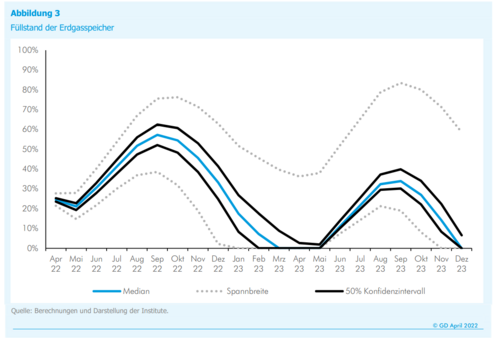
Lastly, also the Gemeinschaftsdiagnose team itself (including IHW) has published in an update in June 2022, stating that the gas gap prediction of April is obsolete, though risks in worst case scenario persist[5]
References[edit | edit source]
- ↑ https://www.iwh-halle.de/fileadmin/user_upload/publications/iwh_policy_notes/iwh-pn_2022-01_de_Gaslieferstopp.pdf
- ↑ 2.0 2.1 https://www.mittelbayerische.de/wirtschaft-nachrichten/44-000-stellen-in-der-oberpfalz-bedroht-21840-art2127280.html
- ↑ 3.0 3.1 “Allein in Stadt und Landkreis Regensburg fielen 15.000 Arbeitsplätze weg, damit würde sich die Zahl der Arbeitslosen verdreifachen.” 02. Juni 2022: Gas-Embargo-Auswirkungen in der Oberpfalz: 44.000 Arbeitsplätze bedroht / Helmberger: „Gas ist kurzfristig nicht ersetzbar – Schaden bei Lieferstopp immens“ https://www.vbw-bayern.de/vbw/PresseCenter/Pressemitteilung-zum-Pressegespr%C3%A4ch-%E2%80%9EGas-Embargo%E2%80%9C-25.jsp ; „Allein im Landkreis Passau fielen 6.000 Arbeitsplätze weg, damit würde sich auf einen Schlag die Zahl der Arbeitslosen mehr als verdoppeln.“ 31. Mai 2022: Gas-Embargo-Auswirkungen in Niederbayern: 43.000 Arbeitsplätze bedroht / Pröckl: „Gas ist kurzfristig nicht ersetzbar – Schaden bei Lieferstopp immens https://www.vbw-bayern.de/vbw/PresseCenter/Pressemitteilung-zum-Pressegespr%C3%A4ch-%E2%80%9EGas-Embargo%E2%80%9C-21.jsp ; „Überall [in Oberbayern] würde sich auf einen Schlag die Zahl der Arbeitslosen verdoppeln“ 24. Mai 2022: Mögliches Gas-Embargo: In Oberbayern wären 176.000 Arbeitsplätze bedroht / Peine: „Gas ist kurzfristig nicht ersetzbar – Schaden bei Lieferstopp immens“ https://www.vbw-bayern.de/vbw/PresseCenter/Pressemitteilung-zum-Pressegespr%C3%A4ch-%E2%80%9EGas-Embargo%E2%80%9C-17.jsp
- ↑ 4.0 4.1 https://www.br.de/nachrichten/bayern/schwaebische-wirtschaft-lehnt-moegliches-gas-embargo-ab,T6kSqo7
- ↑ 5.0 5.1 https://gemeinschaftsdiagnose.de/wp-content/uploads/2022/07/gemeinschaftsdiagnose_sonderauswertung-gasluecke-juni-2022.pdf
- ↑ https://gemeinschaftsdiagnose.de/wp-content/uploads/2022/04/GD_F22_Langfassung_online.pdf
- ↑ https://agsi.gie.eu/#/
- ↑ https://www.diw.de/documents/publikationen/73/diw_01.c.838841.de/diw_aktuell_83.pdf
